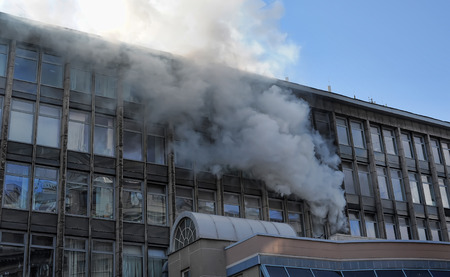It’s 2pm in the afternoon and you get a call that your main corporate center is on fire with employees trapped on the upper floors. As a manager, panic starts to kick in as you mentally go through your preparation for this day asking, “Did I do everything I was supposed to do?”
If you ask yourself that question right now, do you know the answer? Or even where to start? The good news is that building owners responsibility for fire protection is outlined in the most recent requirements of the International Fire Code and there are software systems like Blazemark to help you comply.
Blazemark is a secure cloud-based application that permits cataloguing critical infrastructure and facilities with items such as water supplies, floor plans, shutoffs, annotated photos, GIS information, and other details that both facilities management and first responders require to keep an incident small and manageable. In addition, the software supports improved response, and also helps address any concerns that may come from internal fire and safety audits. Having the emergency preplans on-line also lends itself exceptionally well to tabletop drills and training. Blazemark has seen some insurers offer businesses premium discounts for having preplans. Blazemark preplans also address these requirements from the 2015 International Fire Code:
SECTION 3308 OWNER’S RESPONSIBILITY FOR FIRE PROTECTION
3308.1 Program superintendent. The owner shall designate a person to be the fire prevention program superintendent who shall be responsible for the fire prevention program and ensure that it is carried out through completion of the project. The fire prevention program superintendent shall have the authority to enforce the provisions of this chapter and other provisions as necessary to secure the intent of this chapter. Where guard service is provided, the superintendent shall be responsible for the guard service.
3308.2 Prefire plans. The fire prevention program superintendent shall develop and maintain an approved prefire plan in cooperation with the fire chief. The fire chief and the fire code official shall be notified of changes affecting the utilization of information contained in such prefire plans.
These areas have gotten particular attention following the Deutsche Bank Fire in New York City in 2007, where two firefighters were killed and the Manhattan District Attorney found enough evidence of lax safety to criminally prosecute Bovis Lend Lease for manslaughter and criminally negligent homicide. Although Bovis received protection from prosecution, they had to “willingly acknowledge responsibility for its actions.” (see: https://abc7ny.com/firefighters-still-seeking-justice-10-years-after-deutsche-bank-fire/2310936/) One of the incident findings was the lack of a preplan in accordance with these sections of the New York City Fire Code (IFC). Additionally, a number of large fires at major construction projects has captured the attention of the public, insurers, organized labor, and the emergency services.
In a corporate culture of safety, the use of Blazemark by clients would reduce losses as a result of an event (e.g. fire, leak) by enabling mitigating control steps to be taken and to comply with fire code requirements.
Also the use of Blazemark by Linde clients would reduce event occurrences by enabling management of mitigating steps, e.g. actively manage risk by monitoring maintenance, using the tool for tabletop drills, hands on training.
Part of the issue that we see is that “Building Intelligence”/facility data is often scattered about, or off-site, or rarely kept up to date. Concepts of protection and safety from the building design team often don’t carry over well into the lifecycle of the operation of a facility years or decades later. This is worsened by the trend to outsource facilities management functions, where turnover and turmoil can occur. Without accurate and up-to-date building/site information at their fingertips to maintain safety, facilities management team personnel can be at a severe disadvantage.
In addition, it is not uncommon for integration within emergency services and business to be very limited.
By leveraging our Blazemark solution, we provide the software, services, and expertise to store building intelligence and “tribal knowledge,” and to create communication synthesis between the emergency services and business, and this helps to save property and lives.

